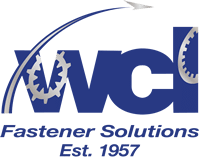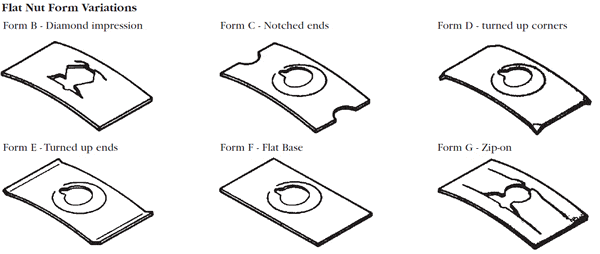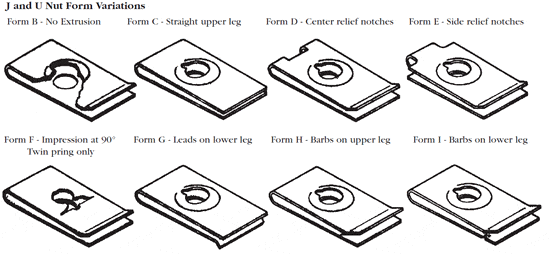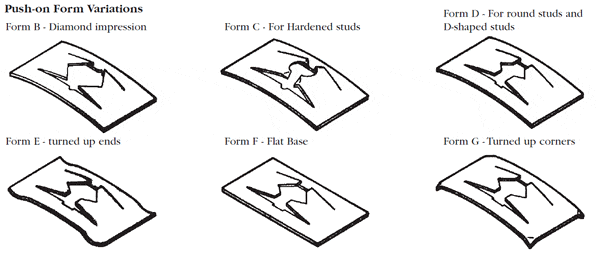Why spring nuts?
Shakeproof spring nuts are one-piece, self-locking, multipurpose devices that prevent screws from loosening due to vibration. The use of spring nuts often eliminates the need for additional fasteners. And, because they allow faster and easier assembly, spring nuts can lower costs of manufacture. Their installation requires no special tools, equipment or skills.
How Spring Nuts Work
SpiraCone Impressions: The SpiraCone impression offers some significant advantages. The funnel lead enables easier starting even if the screw is misaligned. No cross-threading can occur. A greater choice of material thickness is available with SpiraCone nuts. In addition, this stronger form enables the SpiraCone to hold its shape better even when torqued to the extreme. The result is a higher unit clamping force. Because of its design, the spring nut, even if rusted can be easily loosened.
Twin prong Impressions
These spring nuts create both an inward-thread lock and an arched-spring lock. These two locking forces are exerted on the screw as it is torqued and prevent the screw from loosening.
The inward-thread lock is exerted by two arched prongs which, under torque,move inward to engage and lock on the screw thread root. The prongs are free-acting and compensate for screw thread tolerance variation.
The arched-spring lock is exerted by the compression of the arch in both the prongs and base as the screw is torqued. A strong upward motion is exerted against the screw threads.
Wide Range Panel Nuts
These fasteners allow panel thickness variations of as much as one eighth inch to be designed into a product. Wide Range Panel Nuts can accommodate thicknesses from light sheet metal to heavy fiber-board using just one type of fastener.This makes for economy in both stocking and availability.
Form Variations
Drawing accompanying headings for each section show the “A” form of the parts listed.
Variations are indicated by bullets in the Form listings and the drawings are on the inside of each section.
Spring Nuts General Information
Machine Screw Torque and Tensile Limits
| SCREW SIZE |
STANDARD MATERIAL THICKNESS |
RECOMMENDED INSTALLATION TORQUE |
TENSILE LOAD LIMIT (LBS) |
|---|---|---|---|
| SPIRACONE APPLICATIONS | |||
| 4-36 | 0.012 | 4 in-lbs | 110 |
| 4-40 | 0.012 | 4 in-lbs | 110 |
| 6-32 | 0.017 | 6 in-lbs | 150 |
| 8-32 | 0.017 | 8 in-lbs | 250 |
| 10-24 | 0.02 | 14 in-lbs | 450 |
| 10-32 | 0.017 | 10 in-lbs | 500 |
| 1/4-20 | 0.025 | 40 in-lbs | 650 |
| 5/16-18 | 0.025 | 60 in-lbs | 1200 |
| TWIN PRONG APPLICATIONS | |||
| 4-36 | 0.012 | 3 in-lbs | 100 |
| 4-40 | 0.012 | 3 in-lbs | 100 |
| 6-32 | 0.017 | 5 in-lbs | 150 |
| 8-32 | 0.017 | 7 in-lbs | 250 |
| 10-24 | 0.022 | 12 in-lbs | 350 |
| 3/16-24 | 0.022 | 12 in-lbs | 350 |
| 1/4-20 | 0.025 | 30 in-lbs | 600 |
| 5/16-18 | 0.028 | 30 in-lbs | 1000 |
Sheet Metal Screw Torque and Tensile Limits
| SCREW SIZE | THREADS PER INCH | STANDARD MATERIAL THICKNESS |
RECOMMENDED INSTALLATION | TENSILE LOAD LIMIT TORQUE (LBS) |
|---|---|---|---|---|
| SPIRACONE APPLICATIONS | ||||
| 4A | 24 | 0.02 | 8 in-lbs | 450 |
| 4B | 24 | 0.02 | 8 in-lbs | 450 |
| 6A | 18 | 0.02 | 12 in-lbs | 525 |
| 6B | 20 | 0.02 | 12 in-lbs | 525 |
| 8A | 15 | 0.025 | 20 in-lbs | 650 |
| 8B | 18 | 0.025 | 20 in-lbs | 650 |
| 10A | 12 | 0.025 | 30 in-lbs | 1000 |
| 10B | 16 | 0.025 | 30 in-lbs | 1000 |
| 14A | 10 | 0.03 | 60 in-lbs | 1400 |
| 1/4B | 14 | 0.03 | 60 in-lbs | 1400 |
| 5/16B | 12 | 0.04 | 120 in-lbs | 1800 |
| TWIN PRONG APPLICATIONS | ||||
| 4A | 24 | 0.022 | 9 in-lbs | 300 |
| 4B | 24 | 0.022 | 9 in-lbs | 300 |
| 6A | 18 | 0.025 | 11 in-lbs | 400 |
| 6B | 20 | 0.025 | 11 in-lbs | 400 |
| 8A | 15 | 0.028 | 17 in-lbs | 600 |
| 8B | 18 | 0.028 | 17 in-lbs | 600 |
| 10A | 12 | 0.031 | 31 in-lbs | 800 |
| 10B | 16 | 0.031 | 31 in-lbs | 800 |
| 12A | 11 | 0.034 | 34 in-lbs | 900 |
| 12B | 14 | 0.034 | 34 in-lbs | 900 |
| 14A | 10 | 0.037 | 48 in-lbs | 1150 |
| 1/4B | 14 | 0.037 | 48 in-lbs | 1150 |
| 5/16B | 12 | 0.044 | 16 ft-lbs | 1200 |
| 3/8B | 12 | 0.05 | 19 ft-lbs | 2500 |
Acme Thread Bolt Torque and Tensile Limits
| SCREW SIZE |
STANDARD MATERIAL THICKNESS |
RECOMMENDED INSTALLATION TORQUE |
TENSILE LOAD LIMIT (LBS) |
|---|---|---|---|
| SPIRACONE APPLICATIONS | |||
| 5/16-10 | .044 | 135 IN-LBS | 2500 |
| TWIN PRONG APPLICATIONS | |||
| 5/16-10 | .044 | 19 FT-LBS | 2200 |
Clearance Hole — Flat Nuts Only
| SCREW SIZE |
HOLE DIAMETER— SPIRACONE |
HOLE DIAMETER— TWIN PRONG |
|---|---|---|
| 4 | 9/64 | 1/8 |
| 6 | 11/64 | 1/8 |
| 8 | 13/64 | 3/16 |
| 10 | 1/4 | 7/32 |
| 12 | 9/32 | 1/4 |
| 14, 1/4 | 5/16 | 9/32 |
| 5/16 | 3/8 | 11/32 |
Self-retaining fasteners, such as U or J nuts may “snap” onto panel holes. The hole diameters listed will not, of course apply. Specific recommendations for each of these styles is listed for each part.
Finishes
Over 450 different finishes have been used on Spring Nuts in the past years. Virtually any finish may be supplied. The most popular, however, are as follows:
- Mechanical Zinc is a standard finish.
- Phosphate with oil or wax is also a standard finish.
- Phosphate with two coats of paint. The paint protection available includes olive drab, bright green and black phenolics as well as aluminum.
- Plain Oil
Our engineers have had experience with many corrosion problems and will be glad to help you choose.
Materials
Although spring nuts are usually made of heat treated steel, they can be made of any appropriate metal. Screw end protrusion Because more and more screws are being made with header points, chamfer points and gimlet points of various design, we recommend that a thread minimum of one whole pitch of full diameter protrude past the top of the spring nut, whether SpiraCone or Twin Prong design.



